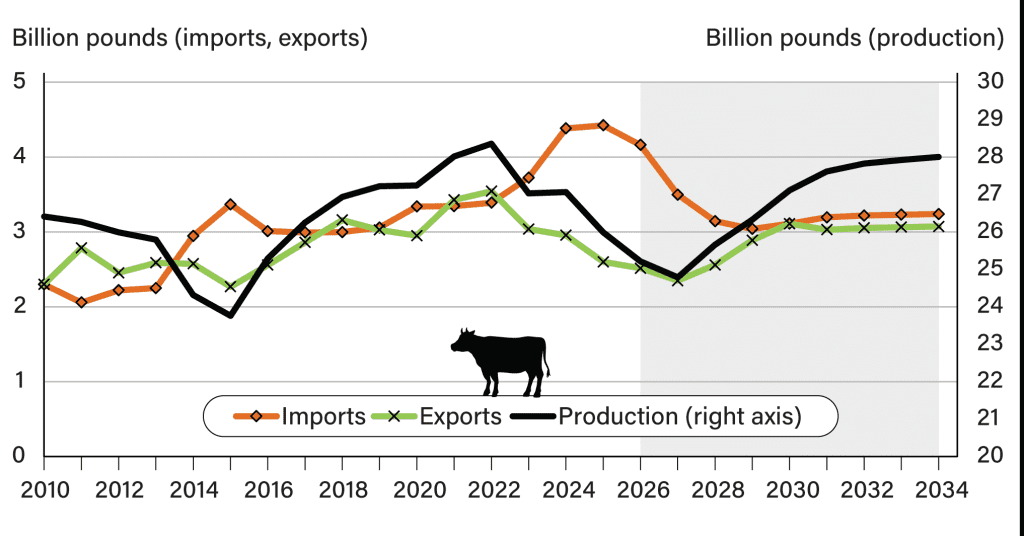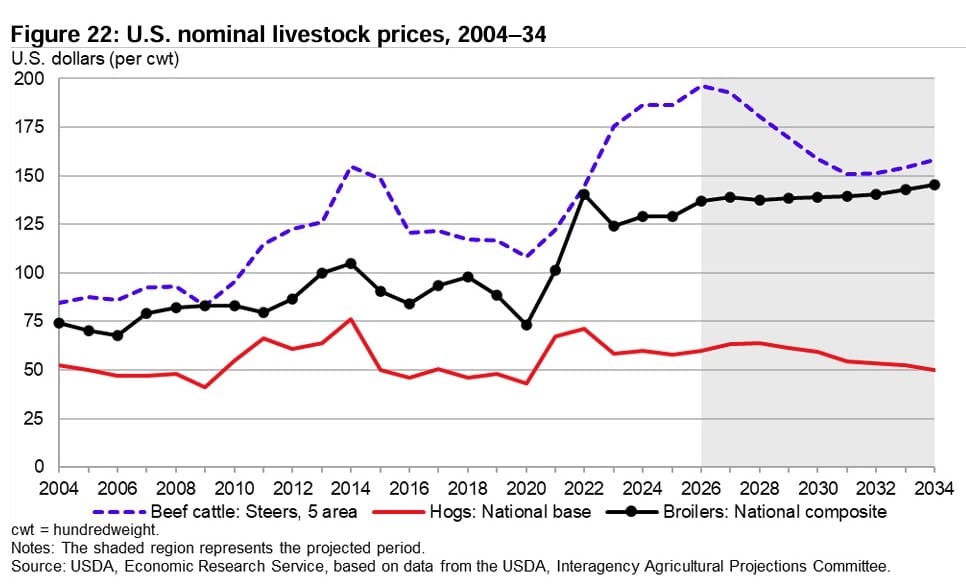UNITED States beef imports are expected to peak this year at about two million tonnes, before falling to around 1.36mt in 2029 as a result of herd rebuilding and higher production, the US Department of Agriculture’s Economic Research Service says in a forecast released late last week.
In the same report, USDA projects US beef exports to decline through to 2027, reaching less than one million tonnes, before recovering to more than 1.4mt in 2030 (see graph).

The analysis is contained in USDA’s Long-Term Projections to 2034 report issued last week.
The report says that US beef production and trade are closely linked, and changes in production typically have a contrasting effect on the pattern of US beef imports.
Domestic US beef production tended to follow a cycle of 8-12 years, driven by cattle producers’ response to price fluctuations and pasture conditions, the report said.
In 2022, US beef production reached a peak of 13.1 million tonnes. Production is projected to hit a low of 11.3 million tonnes in 2027, before climbing through 2034, the final year of USDA’s Agricultural Baseline projections.
As US domestic beef production falls, import volumes are expected to increase, peaking in 2025 at 4.4 billion pounds, or around two million tonnes. Last year’s Australian beef exports to the US reached 394,715 tonnes – close to the all-time annual record trade between the two countries – and are likely to go higher this year as the US enters its critical deficit period.
US beef imports are expected to begin a steep decline, reaching a ten-year low in 2029, as domestic production climbs to better meet domestic beef demand, USDA’s report says.
“US beef export volumes typically are more stable than imports, although exports do tend to follow the same general direction as domestic production,” the report said.
“US beef exports are projected to gradually rise starting in 2027 and continue to grow through 2030 before leveling off for the rest of the projection period. This chart is drawn from USDA Agricultural Projections to 2034, published in February 2025.
The macroeconomic forecasts completed in August reflect modest economic growth in the near term following the heightened volatility that occurred in the aftermath of the COVID pandemic. The report assumes that economic growth remains positive, but global growth rates continue to slow over the long term. Feed prices largely decline or remain static for much of the projection period. It makes no attempt to factor-in any impact from Trump tariffs, due to take effect this week.
US cattle inventories are projected to rebound from a twenty-first century low of 86 million head this year, rising to more than 91 million head late in the ten-year projection period. With growing inventories and continued growth in slaughter weights, US commercial beef production is projected to climb 11.1pc, the report suggests.
Feeder prices to decline 20pc from record high 2026 levels
US beef cattle and feeder steer prices are anticipated to decline by 19.3pc and 24.4pc respectively, from projected record high levels in 2026.
US beef cattle inventories are expected to reverse patterns of decline and begin increasing again during the projection period, with the current liquidation component of the cycle hitting its low-point early in the projections.
Beef production is expected to expand steadily after reaching a low in 2027, based on expectations of consistently strong cattle prices. Projections are premised on assumptions for normal weather which support improved pasture conditions following periods of widespread drought in recent years.
Relatively high cattle prices and firm beef demand in 2024 and 2025 leading into the projection period will likely motivate heifer retentionamong US cattle producers leading to even tighter cattle supplies at the beginning of the forecast period (2025-26).
Thereafter, modest herd growth is expected through 2034. Increasing average carcase weights during the projection period will further support production gains as the herd expands, USDA said.
Beef production is expected to increase from 2028 to 2034 for 11-percent total growth over the projection period.
Per capita beef consumption in the US is projected to be at lower levels throughout the period than observed in the most recent historical years, reaching 26.9kg in 2024 and a low of 24kg in 2027, before climbing above 25kg per capita during 2031–34.
As seen in the graph above, steer prices (purple dotted line) in the US Five-Area marketing region are projected to peak in 2026, reaching US$200/cwt, reflecting extremely tight cattle supplies (see today’s fortnightly feeder steer update).
As producers respond to higher cattle prices early in the projection period, US cattle inventories are expected to expand. The 5-Area region steer prices are projected to decline through to 2031 to US$151/cwt. From 2031–34, steer prices are expected to rise to $158/cwt in 2034, reflecting a turn in the cattle cycle towards contraction.
During the projection period of 2026-34, US beef exports are expected to grow about 22pc to 1.4 million tonnes. Brazil is projected to be the largest global beef exporter over the forecast period, India remains second, followed by Australia and the United States.
Among the major global beef exporters, US market share is expected to increase, largely due to more exportable supplies at the end of the period and declines in exports from Australia and the European Union.

